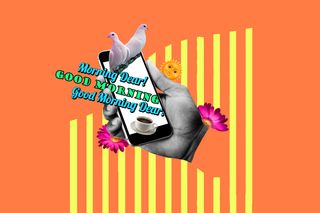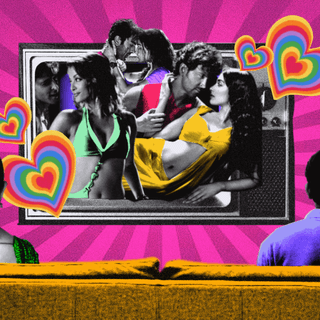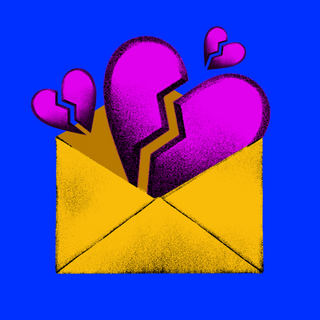
Reclaiming Cringe: Good Morning Messages
Why are good morning messages cringe, when affirmations, pop astrology, and manifestation culture are not?

A series where we discard shame around the objects, activities, and proclivities that others consider deeply uncool.
Good Morning messages: image files containing cloying cursive messages of affirmation, against backdrops of slightly pixelated rose bouquets, coffee cups, stuffed bears, smiling (White) babies, green meadows, or really anything at all. In the ongoing burgeoning of India’s smartphone boom, good morning messages are cheap real estate. What once used to be endearing, ritualistic family tech etiquette has quickly turned unbearable, as these messages filled up storage space like ungovernable locusts of cheesy optimism.
But what makes good morning texts less acceptable than any other digital trend – like dance reels, affirmations posts, or even the feminist reclaiming of spiritual manifesting?
Exacerbating the “cringe,” there’s a ‘tackiness’ factor to the choice of fonts, the stock imagery, and the overlay of the two that made them eyesores to a young, urban, Indian elite.
It’s hard to argue a case for good morning messages, but despite their cultural designation as cringe, they continue to populate smartphone real estate. Good morning messages are like pulp fiction novels, B-grade cinema, or short-form content from small cities that are similarly dismissed as low-brow – but the question here is who exactly finds them so.
Like most cultural phenomena in India, asking why this ubiquitous, distinctly Indian mode of digital communication is “cringe” opens up uncomfortable answers about identity, self-worth, and humor that unsurprisingly have their roots in colonialism.
There’s a term for our discomfort with artifacts like good morning messages: cultural cringe. Sociologists define it as when people in a certain country acquire an inferiority complex for their own culture – here, the way Indians communicate well wishes online), dismissing it in favor of the culture of other countries.
The “DNA” of a good morning message, if you look closely, carries the signatures of a country learning the language of globalization. It signified newness to the technology of the smartphone, the bombastic turns of phrases imply English as a second or third language, and the over-reliance on non-native imagery (read: meadows and white babies) speak to an eagerness to convey beauty in the exact meaning we’ve inherited and imagined it. Somewhere along the way, the mosaic of these imported elements came together into a piece of culture that became uniquely our own – as with “chutneyfied” English, Indian interpretations of popular global street foods, or even TikTok and Instagram trends. These are the same ingredients, however, that deep down induce cultural cringe in the more self-identified global Indians; good morning messages in their phones are the dead giveaways of a culture that’s building a subversive pastiche of what it imagined participating in a global digital culture would be like.
Related on The Swaddle:
A Cultural History of ‘Cringe,’ and How the Internet Made Everything Awkward
Across villages, districts, towns, cities, and metropolises, the mass appeal of good morning messages has remained a staple of Indians’ digital lives. Older generations and family groups are particularly implicated, and sending the prettiest, most creatively worded good morning messages has become an activity unto itself for them.
“Thanks to Whatsapp, I am able to connect with my family. We didn’t have this opportunity five years ago. A good morning message tells them that I am here,” a retired government employee told Outlook.
“I find them endearing but also think they fulfill an important function, albeit more personally – the same function that the heart button on Insta or the Facebook “like” perform – a low-emotional-effort way of letting folks know you’re ok this day,” says Srijan. “It’s a little charming how there’s constant evolution to them with technology… You’ll find that people do not like repeating their good morning messages, adding at least a modicum of effort and personality and not making it look automated and dated.”
The anachronistic fonts and aesthetics of good morning messages begin to make sense when you realize that these are manually created and templatized by individuals whose artistic reference points have been, by default, cursive writing, flowers, nature, and children. It’s like if Yeats’ poetry – from generations of Indians who were exposed to colonial-inspired higher education – were to have a digital counterpart. And that’s exactly what many set out to create. In the minds of the diligent good-morning senders, they’re creating digital art everyday.
The phenomenon of trying to hide an embarrassing cultural trait is almost universal: in Australia, the same quality of perceived boorishness or non-refinement is called ‘bogan.’ “When we choose not to see them, because we reject them on face value as bogan (unfashionable, uncouth, unsophisticated) and avoid them altogether. It flattens our culture, this deep-seated cringe,” wrote Jenna Guillaume.
But as we evolve past our knee-jerk attitudes, the value of these texts and their integral role in bridging physical distances becomes clearer. “When my family members sent it to me, I’d think they were cringe – but this was when I was surrounded by friends 24/7. Now that I’ve graduated, and my friends live all in different parts of the country/world… I understand the good morning forwards,” says Riddhi Shetty.
There’s remarkable similarities between the Australian idea of “bogan” and what we find cringe about good morning messages: As cultural critic Mel Campbell puts it, “we use the idea of the bogan to quarantine ideas of Australianness that alarm or discomfort us. It’s a way of erecting imaginary cultural barriers between ‘us’ and ‘them’.” It makes sense, then, that the resistance to good morning messages comes largely from privileged urbane youth that saw the Internet of the global north, was exposed to its culture, and became spokespersons for what digital culture should look like for us too – anyone or anything that didn’t fit could be laughed away, even deleted en-masse with apps specifically designed to do so.
Today, social media enthusiastically embraces Instagram affirmations, astrology, and spirituality, with byte-sized monetizable content convincing us that trying to send positive thoughts each other’s way was a desirable way to live as long as it’s aesthetically pleasing to do so. And yet, this is exactly what good morning texts do – sans the monetizing, attention-vacuuming component of a social media platform. And so, in 2023, as we tire of the hollow optimism of social media wellness trends, it’s time to ask: were the good morning messages what we needed all along? Arguably, yes – unlike social media trends that are fixated on the self, good morning messages have evolved into a language of care that is unique to us.
“I do get them on a daily basis. Most of them are old aged uncles and aunts and sometimes they forward it in the middle of the night. But at times I used to think, what if they were not there? And that thought comes when there is a sudden death in the family and we start missing the people and what they might have meant through these WhatsApp forwards,” says Rohini.
In a zeitgeist grappling with what it means to stay connected in virtual space, thus, the good morning message is a reminder that shame is all that stands in the way of unabashed well-wishing and cultural reclamation of our inventiveness as a postcolonial nation in churn.
Rohitha Naraharisetty is a Senior Associate Editor at The Swaddle. She writes about the intersection of gender, caste, social movements, and pop culture. She can be found on Instagram at @rohitha_97 or on Twitter at @romimacaronii.
Related


Bollywood’s Soul Resided in Its Love Stories. Are They Disappearing?
